BSC (Hons) Business Management: Business in Practice Exam Solution
VerifiedAdded on 2023/06/05
|5
|2161
|121
Homework Assignment
AI Summary
This document presents a detailed solution to a Business in Practice assignment from the BSC (Hons) Business Management program. The assignment focuses on the classification of different kinds of businesses based on organizational size, organizational structure, and business type. The solution elaborates on micro, small, medium, and large businesses, providing examples for each. It also defines and explains the characteristics of various business structures, including sole traders, partnerships, private limited liability businesses, public limited liability businesses, and cooperatives, with relevant examples for each type. The document includes references to support the analysis and definitions, offering a comprehensive overview of business classifications and structures.
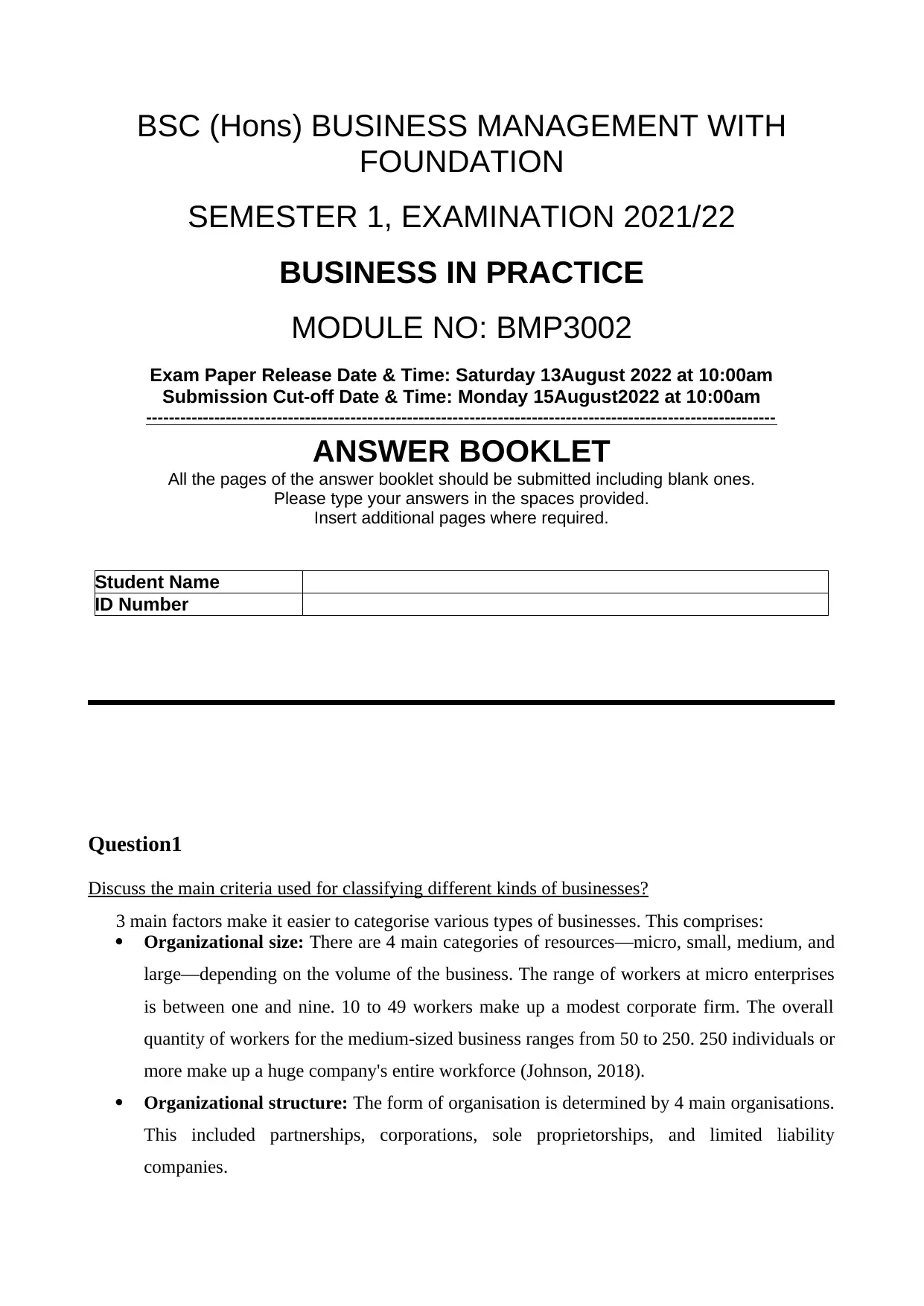
BSC (Hons) BUSINESS MANAGEMENT WITH
FOUNDATION
SEMESTER 1, EXAMINATION 2021/22
BUSINESS IN PRACTICE
MODULE NO: BMP3002
Exam Paper Release Date & Time: Saturday 13August 2022 at 10:00am
Submission Cut-off Date & Time: Monday 15August2022 at 10:00am
---------------------------------------------------------------------------------------------------------------
ANSWER BOOKLET
All the pages of the answer booklet should be submitted including blank ones.
Please type your answers in the spaces provided.
Insert additional pages where required.
Student Name
ID Number
Question1
Discuss the main criteria used for classifying different kinds of businesses?
3 main factors make it easier to categorise various types of businesses. This comprises:
Organizational size: There are 4 main categories of resources—micro, small, medium, and
large—depending on the volume of the business. The range of workers at micro enterprises
is between one and nine. 10 to 49 workers make up a modest corporate firm. The overall
quantity of workers for the medium-sized business ranges from 50 to 250. 250 individuals or
more make up a huge company's entire workforce (Johnson, 2018).
Organizational structure: The form of organisation is determined by 4 main organisations.
This included partnerships, corporations, sole proprietorships, and limited liability
companies.
FOUNDATION
SEMESTER 1, EXAMINATION 2021/22
BUSINESS IN PRACTICE
MODULE NO: BMP3002
Exam Paper Release Date & Time: Saturday 13August 2022 at 10:00am
Submission Cut-off Date & Time: Monday 15August2022 at 10:00am
---------------------------------------------------------------------------------------------------------------
ANSWER BOOKLET
All the pages of the answer booklet should be submitted including blank ones.
Please type your answers in the spaces provided.
Insert additional pages where required.
Student Name
ID Number
Question1
Discuss the main criteria used for classifying different kinds of businesses?
3 main factors make it easier to categorise various types of businesses. This comprises:
Organizational size: There are 4 main categories of resources—micro, small, medium, and
large—depending on the volume of the business. The range of workers at micro enterprises
is between one and nine. 10 to 49 workers make up a modest corporate firm. The overall
quantity of workers for the medium-sized business ranges from 50 to 250. 250 individuals or
more make up a huge company's entire workforce (Johnson, 2018).
Organizational structure: The form of organisation is determined by 4 main organisations.
This included partnerships, corporations, sole proprietorships, and limited liability
companies.
Paraphrase This Document
Need a fresh take? Get an instant paraphrase of this document with our AI Paraphraser
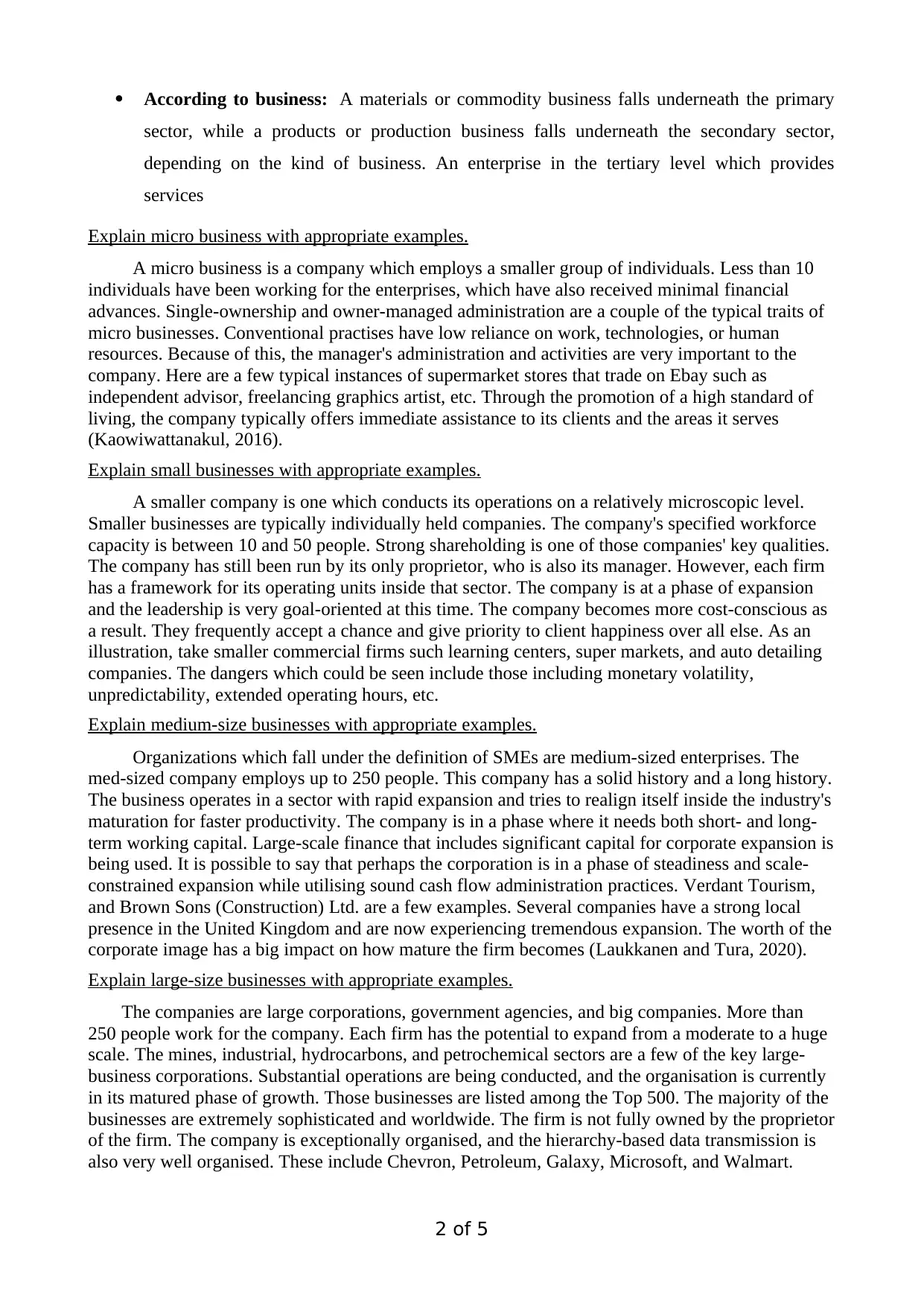
According to business: A materials or commodity business falls underneath the primary
sector, while a products or production business falls underneath the secondary sector,
depending on the kind of business. An enterprise in the tertiary level which provides
services
Explain micro business with appropriate examples.
A micro business is a company which employs a smaller group of individuals. Less than 10
individuals have been working for the enterprises, which have also received minimal financial
advances. Single-ownership and owner-managed administration are a couple of the typical traits of
micro businesses. Conventional practises have low reliance on work, technologies, or human
resources. Because of this, the manager's administration and activities are very important to the
company. Here are a few typical instances of supermarket stores that trade on Ebay such as
independent advisor, freelancing graphics artist, etc. Through the promotion of a high standard of
living, the company typically offers immediate assistance to its clients and the areas it serves
(Kaowiwattanakul, 2016).
Explain small businesses with appropriate examples.
A smaller company is one which conducts its operations on a relatively microscopic level.
Smaller businesses are typically individually held companies. The company's specified workforce
capacity is between 10 and 50 people. Strong shareholding is one of those companies' key qualities.
The company has still been run by its only proprietor, who is also its manager. However, each firm
has a framework for its operating units inside that sector. The company is at a phase of expansion
and the leadership is very goal-oriented at this time. The company becomes more cost-conscious as
a result. They frequently accept a chance and give priority to client happiness over all else. As an
illustration, take smaller commercial firms such learning centers, super markets, and auto detailing
companies. The dangers which could be seen include those including monetary volatility,
unpredictability, extended operating hours, etc.
Explain medium-size businesses with appropriate examples.
Organizations which fall under the definition of SMEs are medium-sized enterprises. The
med-sized company employs up to 250 people. This company has a solid history and a long history.
The business operates in a sector with rapid expansion and tries to realign itself inside the industry's
maturation for faster productivity. The company is in a phase where it needs both short- and long-
term working capital. Large-scale finance that includes significant capital for corporate expansion is
being used. It is possible to say that perhaps the corporation is in a phase of steadiness and scale-
constrained expansion while utilising sound cash flow administration practices. Verdant Tourism,
and Brown Sons (Construction) Ltd. are a few examples. Several companies have a strong local
presence in the United Kingdom and are now experiencing tremendous expansion. The worth of the
corporate image has a big impact on how mature the firm becomes (Laukkanen and Tura, 2020).
Explain large-size businesses with appropriate examples.
The companies are large corporations, government agencies, and big companies. More than
250 people work for the company. Each firm has the potential to expand from a moderate to a huge
scale. The mines, industrial, hydrocarbons, and petrochemical sectors are a few of the key large-
business corporations. Substantial operations are being conducted, and the organisation is currently
in its matured phase of growth. Those businesses are listed among the Top 500. The majority of the
businesses are extremely sophisticated and worldwide. The firm is not fully owned by the proprietor
of the firm. The company is exceptionally organised, and the hierarchy-based data transmission is
also very well organised. These include Chevron, Petroleum, Galaxy, Microsoft, and Walmart.
2 of 5
sector, while a products or production business falls underneath the secondary sector,
depending on the kind of business. An enterprise in the tertiary level which provides
services
Explain micro business with appropriate examples.
A micro business is a company which employs a smaller group of individuals. Less than 10
individuals have been working for the enterprises, which have also received minimal financial
advances. Single-ownership and owner-managed administration are a couple of the typical traits of
micro businesses. Conventional practises have low reliance on work, technologies, or human
resources. Because of this, the manager's administration and activities are very important to the
company. Here are a few typical instances of supermarket stores that trade on Ebay such as
independent advisor, freelancing graphics artist, etc. Through the promotion of a high standard of
living, the company typically offers immediate assistance to its clients and the areas it serves
(Kaowiwattanakul, 2016).
Explain small businesses with appropriate examples.
A smaller company is one which conducts its operations on a relatively microscopic level.
Smaller businesses are typically individually held companies. The company's specified workforce
capacity is between 10 and 50 people. Strong shareholding is one of those companies' key qualities.
The company has still been run by its only proprietor, who is also its manager. However, each firm
has a framework for its operating units inside that sector. The company is at a phase of expansion
and the leadership is very goal-oriented at this time. The company becomes more cost-conscious as
a result. They frequently accept a chance and give priority to client happiness over all else. As an
illustration, take smaller commercial firms such learning centers, super markets, and auto detailing
companies. The dangers which could be seen include those including monetary volatility,
unpredictability, extended operating hours, etc.
Explain medium-size businesses with appropriate examples.
Organizations which fall under the definition of SMEs are medium-sized enterprises. The
med-sized company employs up to 250 people. This company has a solid history and a long history.
The business operates in a sector with rapid expansion and tries to realign itself inside the industry's
maturation for faster productivity. The company is in a phase where it needs both short- and long-
term working capital. Large-scale finance that includes significant capital for corporate expansion is
being used. It is possible to say that perhaps the corporation is in a phase of steadiness and scale-
constrained expansion while utilising sound cash flow administration practices. Verdant Tourism,
and Brown Sons (Construction) Ltd. are a few examples. Several companies have a strong local
presence in the United Kingdom and are now experiencing tremendous expansion. The worth of the
corporate image has a big impact on how mature the firm becomes (Laukkanen and Tura, 2020).
Explain large-size businesses with appropriate examples.
The companies are large corporations, government agencies, and big companies. More than
250 people work for the company. Each firm has the potential to expand from a moderate to a huge
scale. The mines, industrial, hydrocarbons, and petrochemical sectors are a few of the key large-
business corporations. Substantial operations are being conducted, and the organisation is currently
in its matured phase of growth. Those businesses are listed among the Top 500. The majority of the
businesses are extremely sophisticated and worldwide. The firm is not fully owned by the proprietor
of the firm. The company is exceptionally organised, and the hierarchy-based data transmission is
also very well organised. These include Chevron, Petroleum, Galaxy, Microsoft, and Walmart.
2 of 5
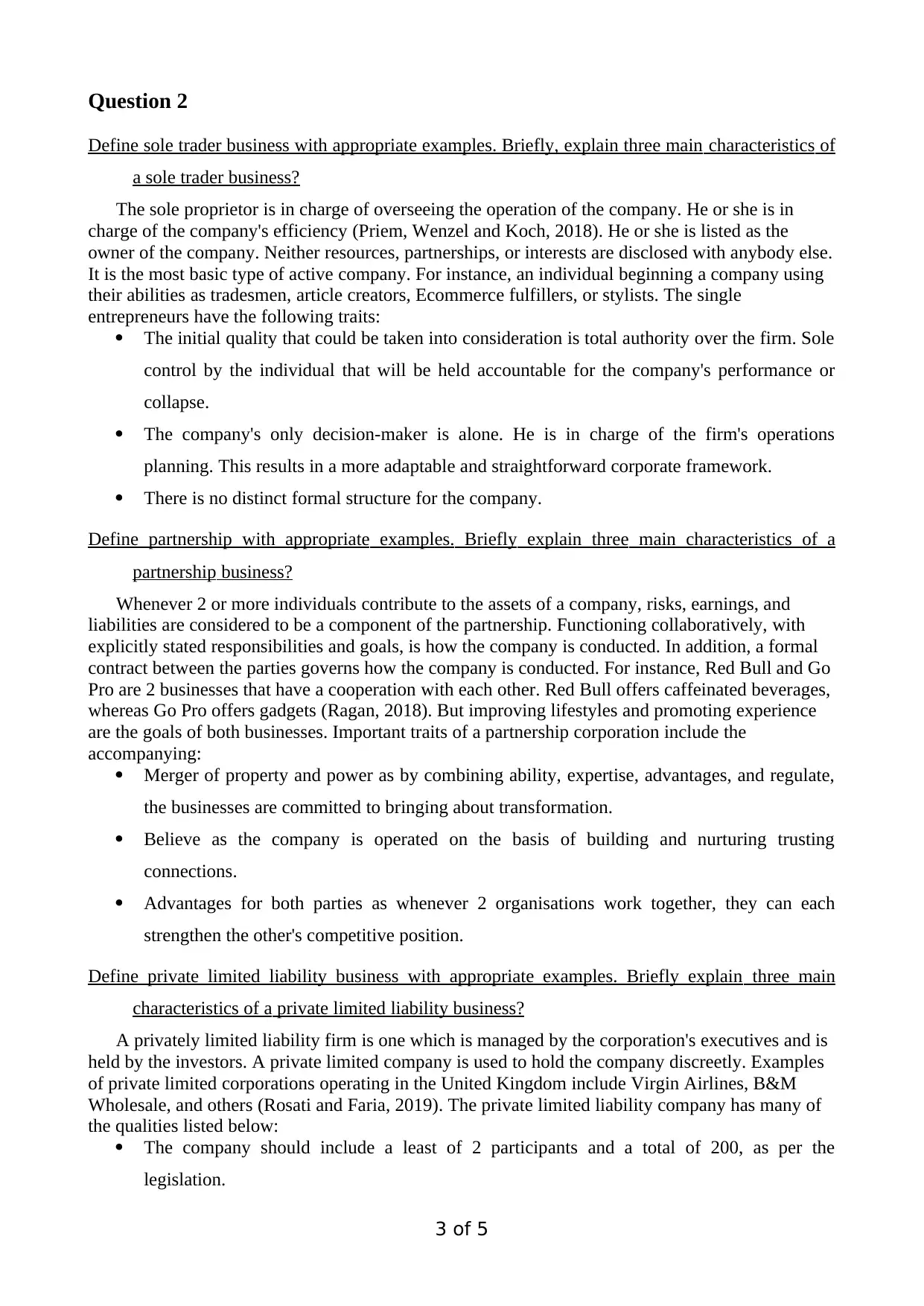
Question 2
Define sole trader business with appropriate examples. Briefly, explain three main characteristics of
a sole trader business?
The sole proprietor is in charge of overseeing the operation of the company. He or she is in
charge of the company's efficiency (Priem, Wenzel and Koch, 2018). He or she is listed as the
owner of the company. Neither resources, partnerships, or interests are disclosed with anybody else.
It is the most basic type of active company. For instance, an individual beginning a company using
their abilities as tradesmen, article creators, Ecommerce fulfillers, or stylists. The single
entrepreneurs have the following traits:
The initial quality that could be taken into consideration is total authority over the firm. Sole
control by the individual that will be held accountable for the company's performance or
collapse.
The company's only decision-maker is alone. He is in charge of the firm's operations
planning. This results in a more adaptable and straightforward corporate framework.
There is no distinct formal structure for the company.
Define partnership with appropriate examples. Briefly explain three main characteristics of a
partnership business?
Whenever 2 or more individuals contribute to the assets of a company, risks, earnings, and
liabilities are considered to be a component of the partnership. Functioning collaboratively, with
explicitly stated responsibilities and goals, is how the company is conducted. In addition, a formal
contract between the parties governs how the company is conducted. For instance, Red Bull and Go
Pro are 2 businesses that have a cooperation with each other. Red Bull offers caffeinated beverages,
whereas Go Pro offers gadgets (Ragan, 2018). But improving lifestyles and promoting experience
are the goals of both businesses. Important traits of a partnership corporation include the
accompanying:
Merger of property and power as by combining ability, expertise, advantages, and regulate,
the businesses are committed to bringing about transformation.
Believe as the company is operated on the basis of building and nurturing trusting
connections.
Advantages for both parties as whenever 2 organisations work together, they can each
strengthen the other's competitive position.
Define private limited liability business with appropriate examples. Briefly explain three main
characteristics of a private limited liability business?
A privately limited liability firm is one which is managed by the corporation's executives and is
held by the investors. A private limited company is used to hold the company discreetly. Examples
of private limited corporations operating in the United Kingdom include Virgin Airlines, B&M
Wholesale, and others (Rosati and Faria, 2019). The private limited liability company has many of
the qualities listed below:
The company should include a least of 2 participants and a total of 200, as per the
legislation.
3 of 5
Define sole trader business with appropriate examples. Briefly, explain three main characteristics of
a sole trader business?
The sole proprietor is in charge of overseeing the operation of the company. He or she is in
charge of the company's efficiency (Priem, Wenzel and Koch, 2018). He or she is listed as the
owner of the company. Neither resources, partnerships, or interests are disclosed with anybody else.
It is the most basic type of active company. For instance, an individual beginning a company using
their abilities as tradesmen, article creators, Ecommerce fulfillers, or stylists. The single
entrepreneurs have the following traits:
The initial quality that could be taken into consideration is total authority over the firm. Sole
control by the individual that will be held accountable for the company's performance or
collapse.
The company's only decision-maker is alone. He is in charge of the firm's operations
planning. This results in a more adaptable and straightforward corporate framework.
There is no distinct formal structure for the company.
Define partnership with appropriate examples. Briefly explain three main characteristics of a
partnership business?
Whenever 2 or more individuals contribute to the assets of a company, risks, earnings, and
liabilities are considered to be a component of the partnership. Functioning collaboratively, with
explicitly stated responsibilities and goals, is how the company is conducted. In addition, a formal
contract between the parties governs how the company is conducted. For instance, Red Bull and Go
Pro are 2 businesses that have a cooperation with each other. Red Bull offers caffeinated beverages,
whereas Go Pro offers gadgets (Ragan, 2018). But improving lifestyles and promoting experience
are the goals of both businesses. Important traits of a partnership corporation include the
accompanying:
Merger of property and power as by combining ability, expertise, advantages, and regulate,
the businesses are committed to bringing about transformation.
Believe as the company is operated on the basis of building and nurturing trusting
connections.
Advantages for both parties as whenever 2 organisations work together, they can each
strengthen the other's competitive position.
Define private limited liability business with appropriate examples. Briefly explain three main
characteristics of a private limited liability business?
A privately limited liability firm is one which is managed by the corporation's executives and is
held by the investors. A private limited company is used to hold the company discreetly. Examples
of private limited corporations operating in the United Kingdom include Virgin Airlines, B&M
Wholesale, and others (Rosati and Faria, 2019). The private limited liability company has many of
the qualities listed below:
The company should include a least of 2 participants and a total of 200, as per the
legislation.
3 of 5
⊘ This is a preview!⊘
Do you want full access?
Subscribe today to unlock all pages.

Trusted by 1+ million students worldwide
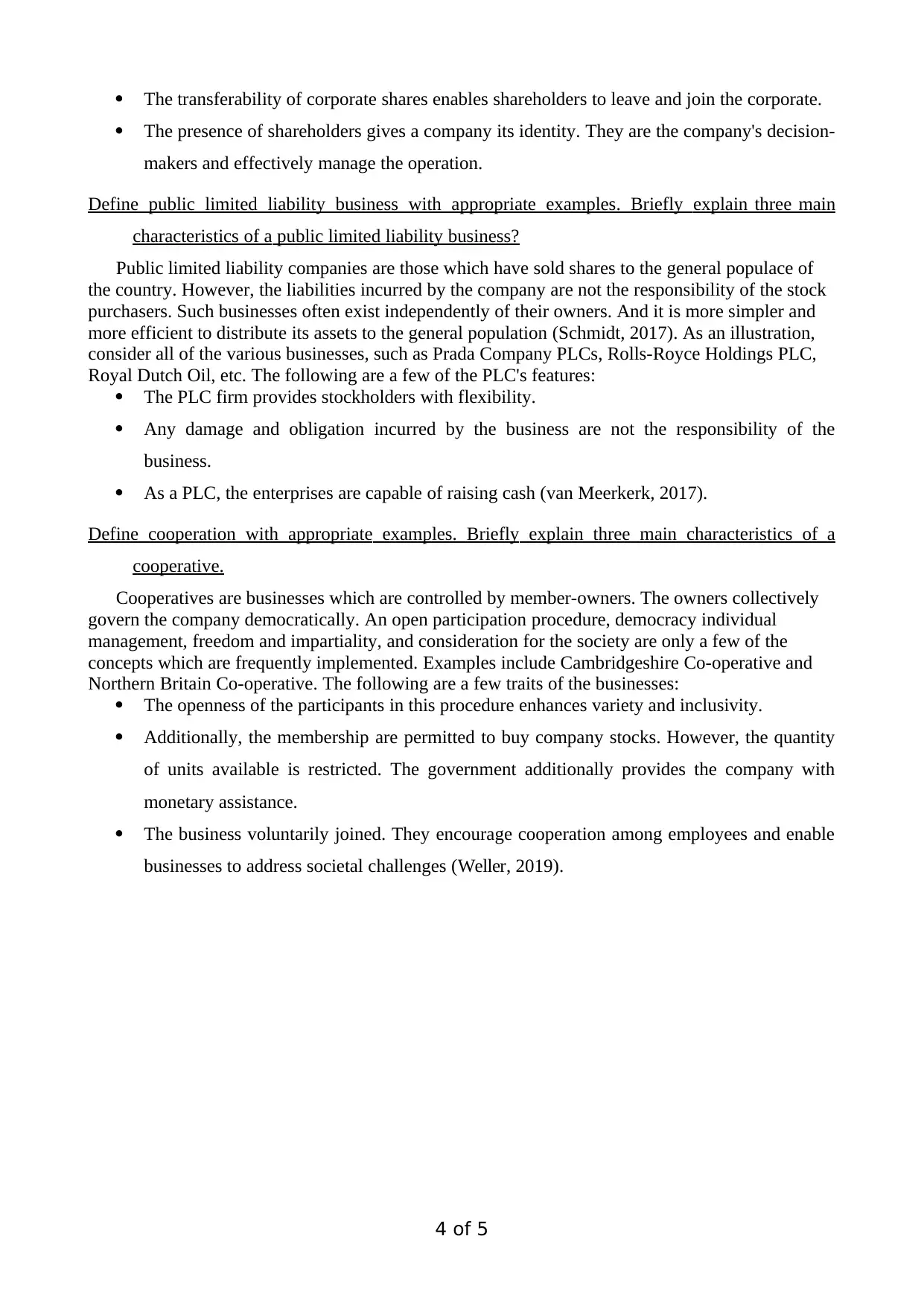
The transferability of corporate shares enables shareholders to leave and join the corporate.
The presence of shareholders gives a company its identity. They are the company's decision-
makers and effectively manage the operation.
Define public limited liability business with appropriate examples. Briefly explain three main
characteristics of a public limited liability business?
Public limited liability companies are those which have sold shares to the general populace of
the country. However, the liabilities incurred by the company are not the responsibility of the stock
purchasers. Such businesses often exist independently of their owners. And it is more simpler and
more efficient to distribute its assets to the general population (Schmidt, 2017). As an illustration,
consider all of the various businesses, such as Prada Company PLCs, Rolls-Royce Holdings PLC,
Royal Dutch Oil, etc. The following are a few of the PLC's features:
The PLC firm provides stockholders with flexibility.
Any damage and obligation incurred by the business are not the responsibility of the
business.
As a PLC, the enterprises are capable of raising cash (van Meerkerk, 2017).
Define cooperation with appropriate examples. Briefly explain three main characteristics of a
cooperative.
Cooperatives are businesses which are controlled by member-owners. The owners collectively
govern the company democratically. An open participation procedure, democracy individual
management, freedom and impartiality, and consideration for the society are only a few of the
concepts which are frequently implemented. Examples include Cambridgeshire Co-operative and
Northern Britain Co-operative. The following are a few traits of the businesses:
The openness of the participants in this procedure enhances variety and inclusivity.
Additionally, the membership are permitted to buy company stocks. However, the quantity
of units available is restricted. The government additionally provides the company with
monetary assistance.
The business voluntarily joined. They encourage cooperation among employees and enable
businesses to address societal challenges (Weller, 2019).
4 of 5
The presence of shareholders gives a company its identity. They are the company's decision-
makers and effectively manage the operation.
Define public limited liability business with appropriate examples. Briefly explain three main
characteristics of a public limited liability business?
Public limited liability companies are those which have sold shares to the general populace of
the country. However, the liabilities incurred by the company are not the responsibility of the stock
purchasers. Such businesses often exist independently of their owners. And it is more simpler and
more efficient to distribute its assets to the general population (Schmidt, 2017). As an illustration,
consider all of the various businesses, such as Prada Company PLCs, Rolls-Royce Holdings PLC,
Royal Dutch Oil, etc. The following are a few of the PLC's features:
The PLC firm provides stockholders with flexibility.
Any damage and obligation incurred by the business are not the responsibility of the
business.
As a PLC, the enterprises are capable of raising cash (van Meerkerk, 2017).
Define cooperation with appropriate examples. Briefly explain three main characteristics of a
cooperative.
Cooperatives are businesses which are controlled by member-owners. The owners collectively
govern the company democratically. An open participation procedure, democracy individual
management, freedom and impartiality, and consideration for the society are only a few of the
concepts which are frequently implemented. Examples include Cambridgeshire Co-operative and
Northern Britain Co-operative. The following are a few traits of the businesses:
The openness of the participants in this procedure enhances variety and inclusivity.
Additionally, the membership are permitted to buy company stocks. However, the quantity
of units available is restricted. The government additionally provides the company with
monetary assistance.
The business voluntarily joined. They encourage cooperation among employees and enable
businesses to address societal challenges (Weller, 2019).
4 of 5
Paraphrase This Document
Need a fresh take? Get an instant paraphrase of this document with our AI Paraphraser
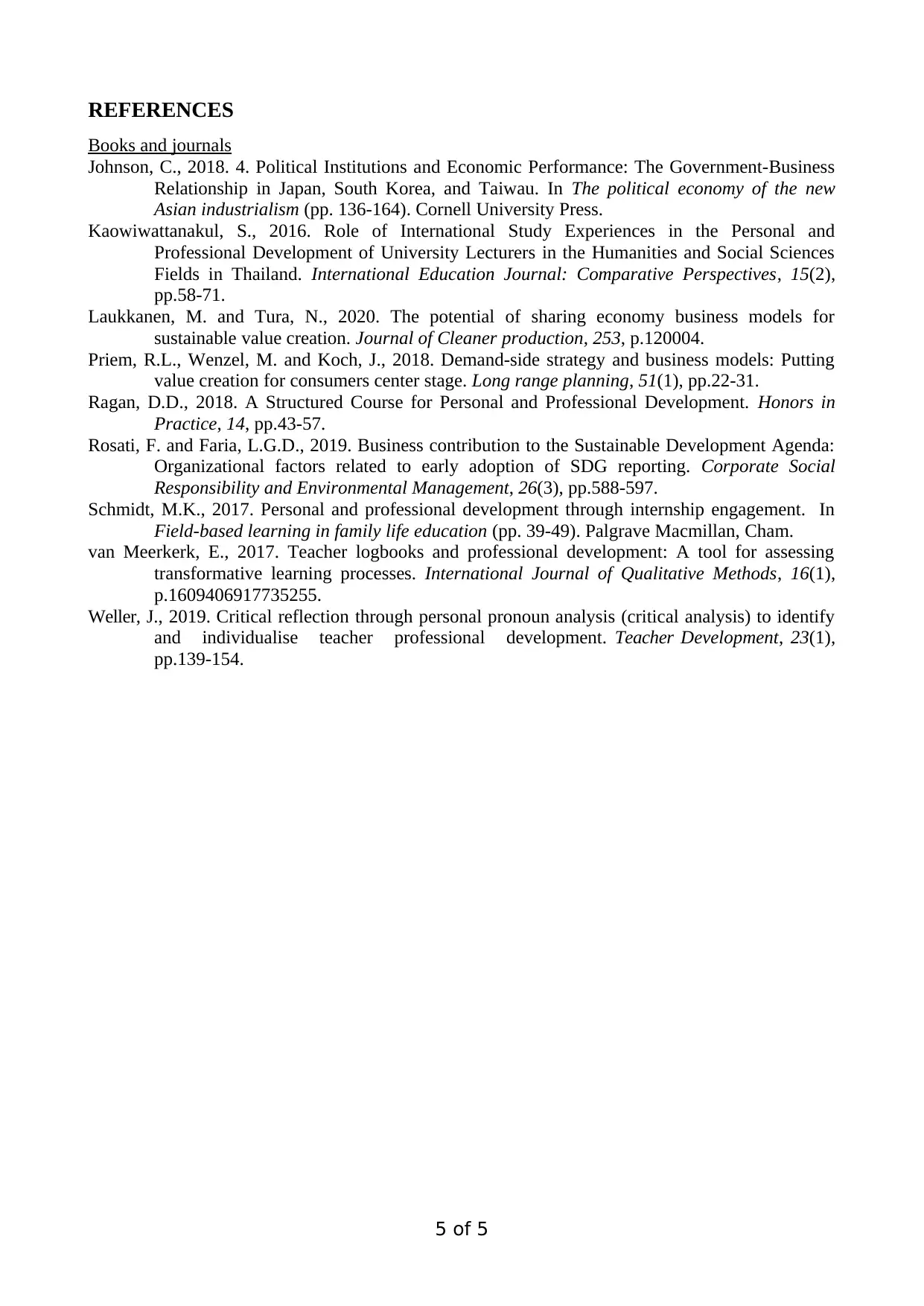
REFERENCES
Books and journals
Johnson, C., 2018. 4. Political Institutions and Economic Performance: The Government-Business
Relationship in Japan, South Korea, and Taiwau. In The political economy of the new
Asian industrialism (pp. 136-164). Cornell University Press.
Kaowiwattanakul, S., 2016. Role of International Study Experiences in the Personal and
Professional Development of University Lecturers in the Humanities and Social Sciences
Fields in Thailand. International Education Journal: Comparative Perspectives, 15(2),
pp.58-71.
Laukkanen, M. and Tura, N., 2020. The potential of sharing economy business models for
sustainable value creation. Journal of Cleaner production, 253, p.120004.
Priem, R.L., Wenzel, M. and Koch, J., 2018. Demand-side strategy and business models: Putting
value creation for consumers center stage. Long range planning, 51(1), pp.22-31.
Ragan, D.D., 2018. A Structured Course for Personal and Professional Development. Honors in
Practice, 14, pp.43-57.
Rosati, F. and Faria, L.G.D., 2019. Business contribution to the Sustainable Development Agenda:
Organizational factors related to early adoption of SDG reporting. Corporate Social
Responsibility and Environmental Management, 26(3), pp.588-597.
Schmidt, M.K., 2017. Personal and professional development through internship engagement. In
Field-based learning in family life education (pp. 39-49). Palgrave Macmillan, Cham.
van Meerkerk, E., 2017. Teacher logbooks and professional development: A tool for assessing
transformative learning processes. International Journal of Qualitative Methods, 16(1),
p.1609406917735255.
Weller, J., 2019. Critical reflection through personal pronoun analysis (critical analysis) to identify
and individualise teacher professional development. Teacher Development, 23(1),
pp.139-154.
5 of 5
Books and journals
Johnson, C., 2018. 4. Political Institutions and Economic Performance: The Government-Business
Relationship in Japan, South Korea, and Taiwau. In The political economy of the new
Asian industrialism (pp. 136-164). Cornell University Press.
Kaowiwattanakul, S., 2016. Role of International Study Experiences in the Personal and
Professional Development of University Lecturers in the Humanities and Social Sciences
Fields in Thailand. International Education Journal: Comparative Perspectives, 15(2),
pp.58-71.
Laukkanen, M. and Tura, N., 2020. The potential of sharing economy business models for
sustainable value creation. Journal of Cleaner production, 253, p.120004.
Priem, R.L., Wenzel, M. and Koch, J., 2018. Demand-side strategy and business models: Putting
value creation for consumers center stage. Long range planning, 51(1), pp.22-31.
Ragan, D.D., 2018. A Structured Course for Personal and Professional Development. Honors in
Practice, 14, pp.43-57.
Rosati, F. and Faria, L.G.D., 2019. Business contribution to the Sustainable Development Agenda:
Organizational factors related to early adoption of SDG reporting. Corporate Social
Responsibility and Environmental Management, 26(3), pp.588-597.
Schmidt, M.K., 2017. Personal and professional development through internship engagement. In
Field-based learning in family life education (pp. 39-49). Palgrave Macmillan, Cham.
van Meerkerk, E., 2017. Teacher logbooks and professional development: A tool for assessing
transformative learning processes. International Journal of Qualitative Methods, 16(1),
p.1609406917735255.
Weller, J., 2019. Critical reflection through personal pronoun analysis (critical analysis) to identify
and individualise teacher professional development. Teacher Development, 23(1),
pp.139-154.
5 of 5
1 out of 5
Related Documents
Your All-in-One AI-Powered Toolkit for Academic Success.
+13062052269
info@desklib.com
Available 24*7 on WhatsApp / Email
![[object Object]](/_next/static/media/star-bottom.7253800d.svg)
Unlock your academic potential
Copyright © 2020–2025 A2Z Services. All Rights Reserved. Developed and managed by ZUCOL.




